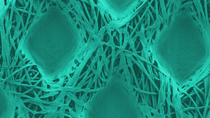Qui sommes-nous ?
Avoiding the transmission of germs in hospital
BASF working with Empa, have evaluated a new antimicrobial coating for textiles that kills pathogens. This coating could be applied to hospital curtains making them antimicrobial.
Countless times a day, patients, visitors, and medical staff in hospitals touch surfaces of all kinds. Door handles, railings or elevator buttons can serve as transport vehicles for pathogens such as bacteria and viruses. Smooth surfaces are comparatively easy to clean after contamination. With porous structures such as textiles, however, this is not so trivial.
The antimicrobial coating was developed by BASF experts from the USA and Germany. BASF's research scientists including the scouting and incubation team in Switzerland, collaborated with the Empa laboratories, which carried out the laboratory evaluations on treated hospital curtains. Using a coating process, fabrics can now be treated in such a way that bacterial and viral pathogens are killed or inhibited in their growth. In hospitals, the treated textiles could be used in future antimicrobial curtains separating patient beds.

Picture: Empa
Active for months
The collaborators involved in the development of this coating were looking for a technology that reliably prevents pathogens from contaminating textiles and stopping the transfer of organisms. The target was to disrupt the pathway of potential infection. This would be useful against multi-resistant bacteria and viral pathogens found in the hospital, preventing the spread of disease.
The researchers ultimately developed a coating in which a formulation containing benzalkonium chloride was evenly incorporated into the hospital curtains. Variables such as concentration, exposure time, processing conditions and drying were optimized. The coating was substantive to the textiles.
Antimicrobial testingwas carried out to evaluate the biocidal effect of the coated textiles. Results showed that the coated textile samples were biocidal against Staphylococci and Pseudomonas bacteria. Populations of these pathogens were significantly reduced or eliminated in just ten minutes. In addition, the coating was also active against viral pathogens: over 99 percent of the viruses tested were killed on the treated fabric.
Additionally, it was determined that the coated fabrics remained effective, even after several months of storage. This allows the ability to stockpile treated materials for future use. In the future, the new process could also be used to quickly and safely treat other textiles, filters, or other porous materials which would be useful in the event of an epidemic or pandemic.